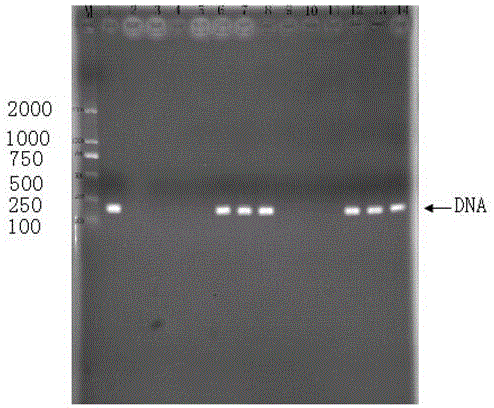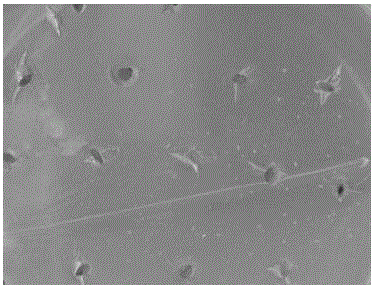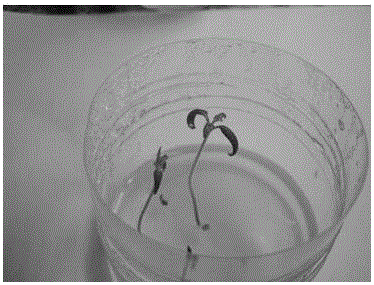Tomato transformation method of agrobacterium tumefaciens mediation
A technology of Agrobacterium tumefaciens and tomato, which is applied in the field of genetic engineering, can solve the problems of long transformation cycle, cumbersome operation process, and low efficiency of tomato genetic transformation, and achieve the effect of strong repeatability and high transformation efficiency
- Summary
- Abstract
- Description
- Claims
- Application Information
AI Technical Summary
Problems solved by technology
Method used
Image
Examples
Embodiment 1
[0036] Take the transformation of tomato with lycopene β-cyclase gene (β-LCY) as an example, including the following:
[0037] (1) Seed disinfection and cultivation
[0038] Select fresh tomato seeds that are plump, of the same size, and soak in water for 2 hours, rinse with sterile water for 3 times after disinfection, and inoculate the seeds into medium A for cultivation;
[0039] (2) Obtaining cotyledon explants
[0040] Tomato cotyledons with a seedling age of 8 days were selected, inoculated on medium B, and used for transformation after dark culture for 1 day;
[0041] (3) Conversion
[0042] Insert the explants into the EHA105 Agrobacterium suspension, and dip for 20 minutes to make the Agrobacterium adsorb to the explants, and the concentration of the suspension is OD 600 =0.2; move the infected explants to sterilized filter paper, absorb the surface liquid, transfer to solid co-cultivation medium C, carry out co-cultivation at 28°C for 3 days, take out the explant...
Embodiment 2
[0055] A tomato transformation method mediated by Agrobacterium tumefaciens, comprising the following steps:
[0056] (1) Seed disinfection and cultivation
[0057] Select fresh tomato seeds that are plump, of the same size, and soak in water for 2 hours, rinse with sterile water for 3-5 times after disinfection, and inoculate the seeds into medium A for cultivation;
[0058] (2) Obtaining cotyledon explants
[0059] Tomato cotyledons with a seedling age of 8 days were selected, inoculated on medium B, and used for transformation after dark culture for 1 day;
[0060] (3) Conversion
[0061] Insert the explants into the EHA105 Agrobacterium suspension, and dip for 20 minutes to make the Agrobacterium adsorb to the explants, and the concentration of the suspension is OD 600 =0.6; move the infected explants to sterilized filter paper, absorb the surface liquid, transfer to solid co-cultivation medium C, carry out co-cultivation at 28°C for 3 days, take out the explants after...
Embodiment 3
[0096] Taking the transformation of tomato with saffron zeaxanthin lyase gene (CsZCD) as an example, the details are as follows:
[0097] 1. Effect of feeder layer on tomato transformation efficiency
[0098] Table 2 shows that the transformation efficiency of tomato without feeder layer cells can reach more than 20%, but co-cultivation with feeder layer cells can effectively increase the transformation efficiency of tomato. Suspension cells of tomato, potato and petunia can be used as feeder cells, but their preparation is cumbersome, time-consuming and consumable.
[0099] Table 2 Effect of feeder cells on genetic transformation of tomato cotyledons
[0100]
[0101] 2. The effect of seedling age on genetic transformation efficiency of tomato
[0102] The transformation rate of tomato cotyledons increased with the increase of seedling age. When the seedling age was 2-3 days, the transformation rate of tomato cotyledons was the lowest at 5.5%, and when the seedling age w...
PUM
 Login to View More
Login to View More Abstract
Description
Claims
Application Information
 Login to View More
Login to View More - R&D
- Intellectual Property
- Life Sciences
- Materials
- Tech Scout
- Unparalleled Data Quality
- Higher Quality Content
- 60% Fewer Hallucinations
Browse by: Latest US Patents, China's latest patents, Technical Efficacy Thesaurus, Application Domain, Technology Topic, Popular Technical Reports.
© 2025 PatSnap. All rights reserved.Legal|Privacy policy|Modern Slavery Act Transparency Statement|Sitemap|About US| Contact US: help@patsnap.com



